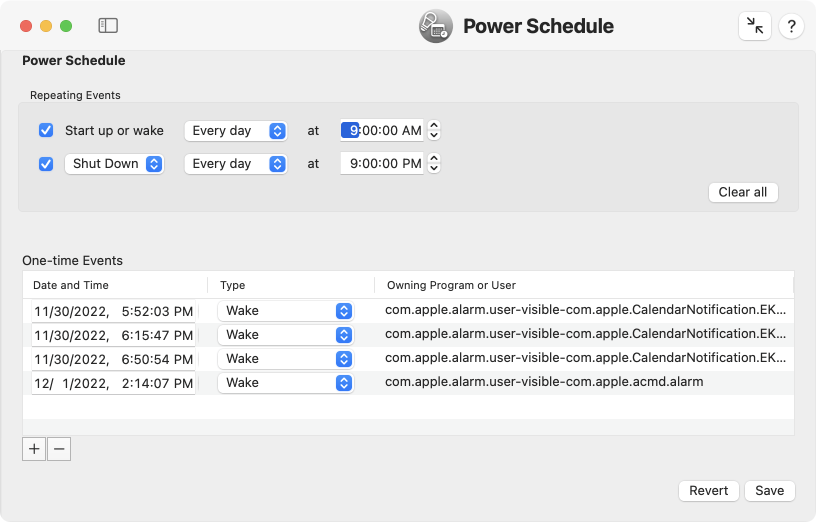The Pane Power Schedule
The Power Schedule pane can be used as a substitute to replace the discontinued features of the previous panes Energy Saver, or Battery respectively, which had been part of the System Preferences application of older versions of macOS. TinkerTool System provides a widely identical range of functions and also allows access to additional settings for scheduling one-time power events.
Dates for Repeating Events
A constantly running clock with an alarm function enables a Mac to turn itself on when it is off. If the Mac is already switched on at that time, but is in sleep or standby mode, a wake-up event is triggered instead, so that macOS is always ready for use at the chosen time. The reverse function, namely
- going to sleep,
- a restart, or
- shutting down the computer
can also be programmed as part of the schedule. Either a single event or a pair of an activating and a deactivating event can be set up for a selected time, which is then repeated daily. In addition, these events can be defined not to really take place every day, but only on certain days of the week. TinkerTool System allows you to set up repeating power events
- every day,
- at weekends,
- every day except on weekends, or
- on a specific day of the week,
- for arbitrary combinations of weekdays (via the menu item Custom…).
You can define such regularly repeating events for the power control of your Mac as follows:
- Open the pane Power Schedule.
- Set a check mark at one or both lines in the box Repeating Events. Use the pop-up buttons to select the appropriate days of the week and the desired times. The upper line is used to define an activating event, the lower line for a deactivating event, whose type can be chosen exactly via an additional pop-up button.
- Click the Save button at the bottom right.
Unless you receive an error message, the schedule will become active and be in effect without further notice. You can delete all repeating events by clicking the button Clear all. This change takes effect immediately without having to click the Save button.
The UNIX command line of macOS additionally allows you to set up schedules with relative times. Apple advises against this as such a schedule cannot be implemented accurately for technical reasons. Such a configuration cannot be edited with TinkerTool System. If this case is detected, an error message will appear in the box in red. You can click the Clear all button to delete the schedule, and then replace it by a simpler one.

Dates for One-Time Events
In addition to the events repeating on a weekly or daily basis, you can also set up one-time events, specified by a fixed date and time. All of the power control event types mentioned so far can be used, either with an enabling or disabling character. Apple recommends to add a comment to each of such events, stating which application or user “owns” the entry.
macOS also uses the schedule of one-time events for itself, to enforce a wake from sleep at specific times. This can trigger maintenance work or send reminders to the user. You can usually identify such entries by an owner remark beginning with com.apple…. Dates set up by macOS itself are automatically cleaned up.
You can define one-time power events as follows:
- Open the pane Power Schedule.
- Click the + button to add a new line at the end of the table.
- In the new row, choose date, time and the type of power event. You can also add a short text as comment.
- Click the Save button at the bottom right.
If you don’t enter a comment for the event, the internal identification of TinkerTool System will be specified automatically as “owner” of the entry.
When saving, macOS may decide to sort the table in a different order at its own discretion. This cannot be prevented.
You can also select one or more lines of the table and delete the associated events by clicking the – button.
General Notes on the Power Schedule
If you have made changes, but not saved them yet, you can use the button Revert to return all settings to their previous states. This includes both repeating and one-time events.
Neither TinkerTool System nor macOS are responsible for implementing the power control events. They are implemented by the Macintosh hardware. This means if you are running macOS in a Virtual Machine or are not using a genuine Apple computer, the schedule may not take effect.
Please also note that the power schedule has unexpected limitations: An automatic shutdown is only possible if the Mac is not in sleep mode at the specified time and at least one user is logged on locally. If older software is currently running which has unsaved documents open, sleep mode, restart or shutdown can be prevented. If the computer is secured by FileVault, it can be turned on automatically, but it cannot start the operating system because a user must enter a password to decrypt the system volume first.
If you are logged in as a user with administrative rights, you are allowed to change the power schedule settings without additionally entering a password. This corresponds to the simplified security policy that Apple used in previous versions of the System Settings application.